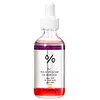What's inside
What's inside
 Key Ingredients
Key Ingredients

 Benefits
Benefits

 Concerns
Concerns

 Ingredients Side-by-side
Ingredients Side-by-side

Water
Skin ConditioningDiphenyl Dimethicone
EmollientButylene Glycol
HumectantNiacinamide
Smoothing1,2-Hexanediol
Skin ConditioningSodium Chloride
MaskingPentylene Glycol
Skin ConditioningBrassica Oleracea Capitata Leaf Extract
Skin ConditioningBrassica Oleracea Italica Extract
AstringentApium Graveolens Extract
Skin ConditioningCucumis Sativus Extract
Skin ConditioningBrassica Oleracea Acephala Leaf Extract
HumectantCarum Petroselinum Extract
Skin ConditioningGlycerin
HumectantEclipta Prostrata Extract
Skin ConditioningEclipta Prostrata Leaf Extract
Skin ConditioningSodium Hyaluronate
HumectantEthylhexylglycerin
Skin ConditioningMoringa Oleifera Seed Oil
EmollientParfum
MaskingCaprylic/Capric Triglyceride
MaskingHesperidin Methyl Chalcone
AntioxidantHydrogenated Lecithin
EmulsifyingPolyglyceryl-10 Diisostearate
EmulsifyingArnica Montana Flower Extract
MaskingHamamelis Virginiana Bark/Leaf/Twig Extract
Skin ConditioningMalva Sylvestris Flower Extract
Skin ConditioningRuscus Aculeatus Root Extract
AstringentAesculus Hippocastanum Extract
AntioxidantMenadione
MaskingTocopherol
AntioxidantWater, Diphenyl Dimethicone, Butylene Glycol, Niacinamide, 1,2-Hexanediol, Sodium Chloride, Pentylene Glycol, Brassica Oleracea Capitata Leaf Extract, Brassica Oleracea Italica Extract, Apium Graveolens Extract, Cucumis Sativus Extract, Brassica Oleracea Acephala Leaf Extract, Carum Petroselinum Extract, Glycerin, Eclipta Prostrata Extract, Eclipta Prostrata Leaf Extract, Sodium Hyaluronate, Ethylhexylglycerin, Moringa Oleifera Seed Oil, Parfum, Caprylic/Capric Triglyceride, Hesperidin Methyl Chalcone, Hydrogenated Lecithin, Polyglyceryl-10 Diisostearate, Arnica Montana Flower Extract, Hamamelis Virginiana Bark/Leaf/Twig Extract, Malva Sylvestris Flower Extract, Ruscus Aculeatus Root Extract, Aesculus Hippocastanum Extract, Menadione, Tocopherol
 Reviews
Reviews

Ingredients Explained
These ingredients are found in both products.
Ingredients higher up in an ingredient list are typically present in a larger amount.
Niacinamide is a multitasking form of vitamin B3 that strengthens the skin barrier, reduces pores and dark spots, regulates oil, and improves signs of aging.
And the best part? It's gentle and well-tolerated by most skin types, including sensitive and reactive skin.
You might have heard of "niacin flush", or the reddening of skin that causes itchiness. Niacinamide has not been found to cause this.
In very rare cases, some individuals may not be able to tolerate niacinamide at all or experience an allergic reaction to it.
If you are experiencing flaking, irritation, and dryness with this ingredient, be sure to double check all your products as this ingredient can be found in all categories of skincare.
When incorporating niacinamide into your routine, look out for concentration amounts. Typically, 5% niacinamide provides benefits such as fading dark spots. However, if you have sensitive skin, it is better to begin with a smaller concentration.
When you apply niacinamide to your skin, your body converts it into nicotinamide adenine dinucleotide (NAD). NAD is an essential coenzyme that is already found in your cells as "fuel" and powers countless biological processes.
In your skin, NAD helps repair cell damage, produce new healthy cells, support collagen production, strengthen the skin barrier, and fight environmental stressors (like UV and pollution).
Our natural NAD levels start to decline with age, leading to slower skin repair, visible aging, and a weaker skin barrier. By providing your skin niacinamide, you're recharging your skin's NAD levels. This leads to stronger, healthier, and younger looking skin.
Another name for vitamin B3 is nicotinamide. This vitamin is water-soluble and our bodies don't store it. We obtain Vitamin B3 from either food or skincare. Meat, fish, wheat, yeast, and leafy greens contain vitamin B3.
The type of niacinamide used in skincare is synthetically created.
Learn more about NiacinamidePentylene glycol is typically used within a product to thicken it. It also adds a smooth, soft, and moisturizing feel to the product. It is naturally found in plants such as sugar beets.
The hydrophilic trait of Pentylene Glycol makes it a humectant. As a humectant, Pentylene Glycol helps draw moisture from the air to your skin. This can help keep your skin hydrated.
This property also makes Pentylene Glycol a great texture enhancer. It can also help thicken or stabilize a product.
Pentylene Glycol also acts as a mild preservative and helps to keep a product microbe-free.
Some people may experience mild eye and skin irritation from Pentylene Glycol. We always recommend speaking with a professional about using this ingredient in your routine.
Pentylene Glycol has a low molecular weight and is part of the 1,2-glycol family.
Learn more about Pentylene GlycolWater. It's the most common cosmetic ingredient of all. You'll usually see it at the top of ingredient lists, meaning that it makes up the largest part of the product.
So why is it so popular? Water most often acts as a solvent - this means that it helps dissolve other ingredients into the formulation.
You'll also recognize water as that liquid we all need to stay alive. If you see this, drink a glass of water. Stay hydrated!
Learn more about Water